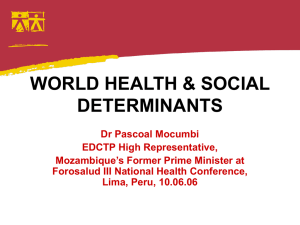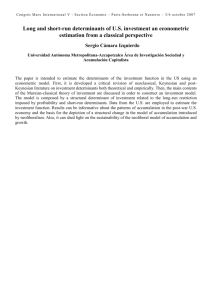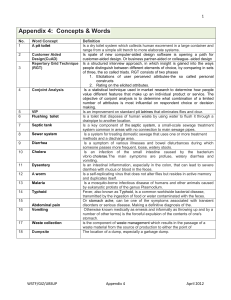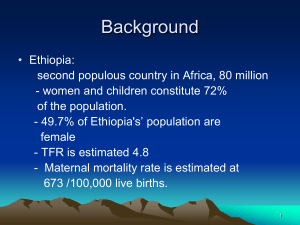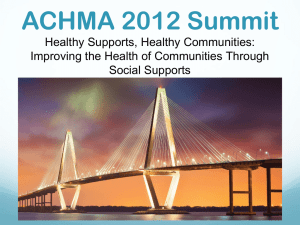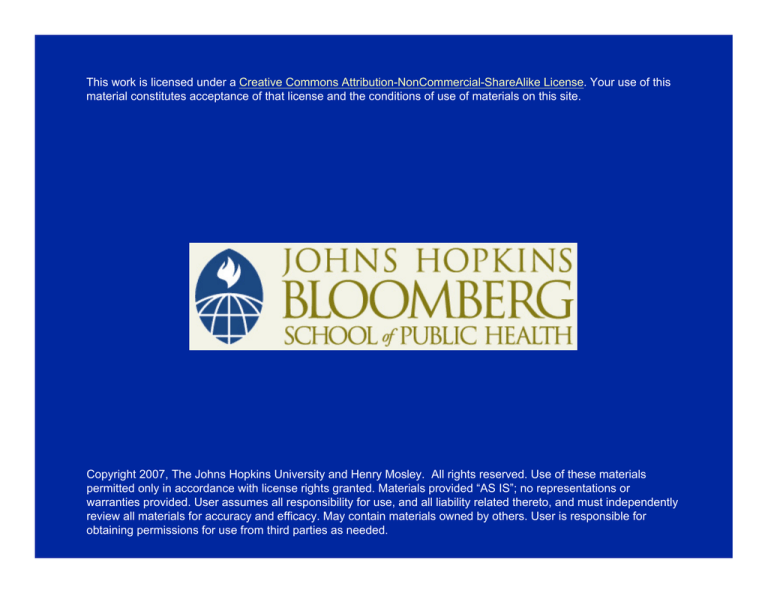
This work is licensed under a Creative Commons Attribution-NonCommercial-ShareAlike License. Your use of this
material constitutes acceptance of that license and the conditions of use of materials on this site.
Copyright 2007, The Johns Hopkins University and Henry Mosley. All rights reserved. Use of these materials
permitted only in accordance with license rights granted. Materials provided “AS IS”; no representations or
warranties provided. User assumes all responsibility for use, and all liability related thereto, and must independently
review all materials for accuracy and efficacy. May contain materials owned by others. User is responsible for
obtaining permissions for use from third parties as needed.
Session 2
Identifying Measurable Variables
and Specifying Their Relationships
W. Henry Mosley, MD, MPH
Professor and Chairman
Department of Population Dynamics
Johns Hopkins University
School of Hygiene and Public Health
Illustrative Outcomes of Interest in
Population-Based Studies
• Demographic
– Fertility, Mortality, Migration, Marriage, etc.
• Socio-economic
– Labor-force participation, school attainment, etc.
• Health
– morbidity, nutrition, disability, etc.
• Behavioral
– Contraception, smoking, violence, etc.
Identifying Variables and Their
Relationships in Population-Based Studies
I. Define the Outcome and Associated Variables
II. Specify Causal Relationships
III. Identify Measurable Variables in a Data Set
Specification of Study Variables and
Their Relationships Establishes
•
•
•
•
the population data to be studied
the data required for the research
the statistical analysis to be conducted
the interpretation and generalizability of
the results
Chart 1
Association of Diarrhea and Bottlefeeding
Diarrhea
Cases
Bottle Feeding
100
50%
Breastfeeding
100
200
50%
100%
Chart 2
Diarrheal
Cases
No
Diarrhea
Bottle feeding
100
40
Breastfeeding
100
200
160
200
Relative Risk of Diarrhea with Bottlefeeding:
100 . 100
= 4.00
=
.
40 160
Determinants of Diarrhea
• Environmental Contamination
–
–
–
–
–
–
–
Water sources, quality
Latrine facility
Food Storage/refrigeration
Use of soap, handwashing
Household crowding (other children)
Housing construction
Use of baby bottles
• Personal Illness Control
– Measles immunization
• Dietary Intake
– Breastfeeding, weaning practice
Chart 3
Association of Diarrhea with Bottlefeeding and
with Toilet Facilities Among a Clinic Population
Number
Diarrhea
Number
Cases
%
All children
500
100
20.0
Bottlefeeding
Breastfeeding
100
400
50
50
50.0
12.5
Other toilet
Indoor toilet
250
250
70
30
28.0
12.0
Chart 4
Association of Diarrhea with Bottlefeeding
Among Families With and Without Indoor Toilets
Number Diarrhea Cases
Number
%
Other toilet
Bottle feeding
Breast feeding
50
200
40
30
80.0
15.0
Indoor toilet
Bottle feeding
Breast feeding
50
200
10
20
20.0
10.0
500
100
20.0
Specifying Causal Relationships
1. A Direct Relationship
Independent
Variable
Dependent
Variable
Causes, determines
or influences
2. An Indirect Relationship
or
s
on
t
s
ac
e
rat
e
p
o
Intervening
Variables*
Independent
Variable
*Also: Intermediate/Proximate variables
Cau
ses
or
infl , dete
rm
uen
ine
ces
s
Dependent
Variable
Proximate Determinants of Fertility
Socioeconomic
Variables
Proximate
Determinants
Fertility
(live births)
Proximate Determinants of Fertility
(Kingsley Davis and Judith Blake)
• Factors Affecting Exposure to Intercourse
–
–
–
–
–
–
Age of marriage (sexual union)
Permanent celibacy
Divorce/separation/death of husband
Voluntary abstinence
Involuntary abstinence (illness, etc.)
Coital frequency
Proximate Determinants of Fertility
(Kingsley Davis and Judith Blake)
Continued....
• Factors Affecting Exposure to Conception
– Fecundity affected by disease, etc.
– Contraception
– Voluntary infecundity (sterilization)
• Factors Affecting Gestation/Successful
Parturition
– Involuntary fetal mortality
– Voluntary fetal mortality (abortion)
Proximate Determinants of Child Survival
Socioeconomic
SocioeconomicDeterminants
Determinants
Maternal
Maternal
factors
factors
Environmental
Environmental
contamination
contamination
Dietary
Dietary
intake
intake
Injury
Injury
Sick
Sick
Healthy
Healthy
Prevention
Personal
Personal
illness
illness
control
control
Treatment
Growth
Growth
faltering
faltering
Mortality
Mortality
Conceptual Framework for the Analysis of
Perinatal Mortality
Distant
Factors
Socioeconomic
Factors
Pre-pregnancy
Conditions
Pregnancy
Specific Factors
Nutritional
Status
Antenatal
Care
Maternal
Morbidity
Intrapartum
Conditions
Fetal
Factors
Fetal Biological
Factors
Accidents at
Delivery
Outcome
Perinatal
Death
Conceptual Framework for the Analysis of
Perinatal Mortality
Distant Determinants
Socio-Demographic
Variables
Pre-pregnancy
Conditions
•
•
•
•
•
•
•
•
•
• Age at Event
• Parity/Gravity
• Maternal Nutritional
Status
• Past Obstetric History
• Inter-pregnancy Interval
• Preference/Intention
Urban/Rural Residence
Region
Ethnicity
Religion
Women’s Education
Husband’s Education
Gainful employment
Husband’s Occupation
Durable Goods/Housing
Characteristics
Items for Summative Scale for
Socioeconomic Status
•
•
•
•
•
•
•
•
•
Car
Bicycle/motorcycle
Electricity
Refrigerator
Gas/electric stove
Television
Cement/wood floor
Toilet
Indoor Water
Conceptual Framework for the Analysis of
Perinatal Mortality
Pregnancy Specific Determinants
Antenatal Factors
Intranatal Factors
•
•
•
•
• Rupture of membranes
prior to labor
• Delivery assisted by
trained person
• Place of delivery
• Reported symptoms of
prolonged labor,
hemorrhage, sepsis,
eclampsia
Trimester of 1st visit
Number of visits
Tetanus injection
Bleeding during
2nd/3rd trimester
Diagnostic Algorithms for
Obstetric Complications
Complications
Definition
• Eclampsia
Convulsions (not from fever) reported during
pregnancy or during labor/delivery and no
convulsions experienced outside of
pregnancy
• Sepsis
Report of sickness during labor and or
delivery with a very high fever
• Intrapartum
Hemorrhage
Report of losing a lot of blood around time of
labor or delivery or attendant recognized
bleeding as severe problem or report of
manual evacuation of placenta
• Prolonged
labor
Report of heavy labor lasting longer than 12
hours
Diagnostic Algorithm for Measles
•
•
•
•
Child 5 months or more old
Child had fever
Blotchy rash lasting 3 or more days
Peeling or darkening of the skin among
children who survived 5 or more days
• Cough, running nose or red eyes
• Other cases of measles
• Above conditions occurred 1-3 months prior
to death
Note: First four signs required for measles diagnosis
Pregnancy Specific Determinants
Antenatal Factors
Intranatal Factors
•
•
•
•
• Rupture of membranes
prior to labor
• Delivery assisted by
trained person
• Place of delivery
• Reported symptoms of
prolonged labor,
hemorrhage, sepsis,
eclampsia
Trimester of 1st visit
Number of visits
Tetanus injection
Bleeding during
2nd/3rd trimester
Items for Summative Scale for Antenatal Care Based on
WHO Essential Care Package
•
•
•
•
•
•
•
•
Included in the Questionnaire
Checked baby's position
• Referred to hospital
Tetanus immunization
• Internal examination
Abdomen measured
• Iron tablets
Urine test
• Danger signs of
pregnancy
Blood test
• Family planning
Weight
• Postpartum care
Height
• Breastfeeding
Blood pressure
Not Included in the Questionnaire
Pap smear
Culture for Gonorrhea
Hemoglobin measured
Obstetrical history taken
Schema for Breastfeeding
Definition
Breastfeeding
Partial
Full
Token
Exclusive
Almost Exclusive
No other liquid
or solid is
given
to the infant
Vitamins,
minerals, water,
juice, or ritualistic
feeds given
infrequently in
addition to
breastfeeds
High
Medium
Low
minimal,
occasional
irregular
breastfeeds
Identifying Measurable Variables
in Data Sets
•
•
•
•
•
Directly Measurable Variables
Construction of Scales
Use of Diagnostic Algorithms
Use of Reference/Standard Definitions
Use of Proxy Variables


